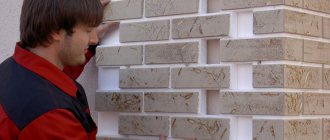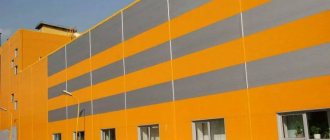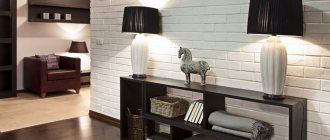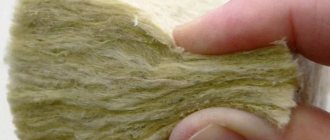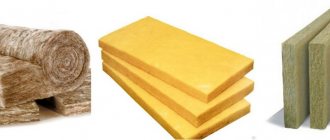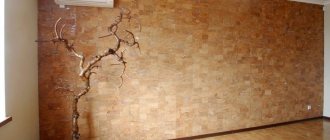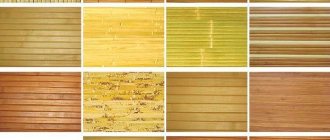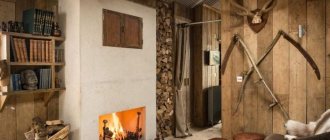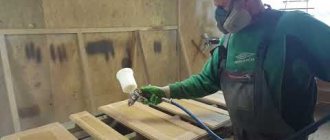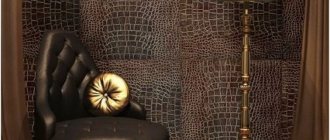- home
- laminated chipboard
- Furniture made from laminated chipboard
- Chipboard panels
>
>
>
When decorating an interior, many people want to distinguish themselves and come up with various non-standard solutions.
Laminated chipboard panels fell under this category; they began to decorate both walls and ceilings, and are even used in furniture design. Chipboard panels, as they have already proven, are excellent interior decor. Hurry up to buy laminated chipboard panels at the best price from. What are the advantages of laminated chipboard panels?
- Wide range of colors;
- Low price;
- Environmental friendliness and safety;
- Wear resistance;
- Long service life.
Types of wall panels for interior decoration
Cladding walls with panels helps to make repairs quickly, get excellent results and significantly save on the cost of repairs. After all, they can cover up the lack of plaster, uneven corners and other possible construction flaws. With an abundance of choice, deciding which materials to use is not easy. Let's figure out which types and why are the most interesting today, and what to give preference to.
Slatted panels
Such wall panels are used to decorate any premises, except, perhaps, for children. The length of the planks ranges from 2.4 to 3.6 m, the width from 12.5 to 30 cm, the thickness of the planks is 8-12 mm. They can be white or colored, imitating various types of wood. Indispensable for rooms with a small area and many corners. Slat panels easily cover internal and external corners. Tenons or grooves are used to connect the slats to each other. To make the joints invisible, manufacturers offer a huge number of corners, plugs, baseboards and other products that make installation simple and neat; with minimal experience, you can do it yourself.
When installing plastic wall panels for interior decoration, plugs and corners will hide the seams and complement the overall picture if chosen correctly Source liveposts.ru
Slatted wall panels made of wood are called “lining” and are actively used. They can be covered with stain or varnish, or simply painted, creating an extraordinary interior. Often the lining is given the effect of aged wood. Recently, the popularity of “lining” has decreased slightly, giving way to more modern materials, but dachas, summer kitchens and loggias are finished with this type of cladding.
Leafy
This species is large in size. But it allows you to quickly install wall panels over a large area. Sheets 122x244 cm and 6 mm thick are made from multi-layer fiberboard with various impregnations or from PVC. They often imitate stone, wood and are attached to the wall with glue. They are light, durable, and you don’t need to make lathing for their installation.
Imitation brick or stone in wall panels for interior decoration - always look original Source kreotech.de
Tiled
Cladding with tiled wall panels allows you to give the walls volume, obtain relief images, and with their help you can create an absolutely unique interior. Interlocking connections make it possible to obtain large-area wall coverings from small slabs (90x90 cm, 30x30 cm). They imitate expensive wood species or natural stone. They are often used to decorate living rooms and fireplace areas.
Wooden panels for interior wall decoration from different “tree species” Source decoratorist.com
Technology and installation principle
Most often, in private housing construction, laminated chipboard wall panels are chosen for interior decoration. They are beautiful, durable and reliable. However, their service life will directly depend on the correctness of the installation work performed. There are several options for fixing chipboard panels to the wall. Everyone can choose for themselves which is the best method in their situation, because they have their pros and cons.
Fixation with glue
The simplest option, but requiring careful preparation. It is best to use it when working with tile products, which can be the size of tiles. Thanks to a similar method of laying tiles, an excellent visual effect is obtained.
- Much attention is paid to preparing the walls. Requirements: no defects, chips, greasy stains, protruding elements. The wall must be perfectly flat. Then it is primed in two layers intermittently. This will improve grip. And in order to glue the chipboard panels evenly, you can make level markings in advance.
- In order for the finishing material to adapt to operating conditions, it must be placed in the room before work begins. 2 days will be enough. Now the boards are ready for processing and gluing. The reverse side is made rough using sandpaper, this will improve adhesion to the surface.
- All that remains is to apply glue to this side of the chipboard. The glue can be polyurethane foam, liquid nails or a special composition. The mixture is applied dotted or zigzag.
- The final stage is to place the slab in its place according to the markings and press it so that it sets.
What materials are they made from?
Decorative wall panels are made from chipboard, fiberboard, MDF or PVC.
Today, new materials for their manufacture appear almost every day. Panels made of stone chips appeared, and glass panels also found their admirers. Which material to choose can only be determined if you have the necessary information.
See also: Catalog of companies that specialize in finishing materials.
Tree
Wood has been used for the manufacture of cladding for a very long time. Initially, such wall panels were made from solid wood, were expensive and inaccessible to most buyers. Today you can buy combined wooden panels, the cost of which is much lower. The front layer of such products is valuable types of wood applied to a pine or spruce base. The development of technology has made it possible to produce similar high-quality finishing materials from waste from the woodworking industry (sawdust, wood chips). This made it possible to decorate walls in rooms imitating expensive types of wood, very inexpensively. Wood-look wall panels are appropriate in any interior. However, cladding with natural wood has not lost its relevance and can favorably emphasize the status of the owner of the room.
Panels for interior decoration with natural wood cladding always look expensive Source geenen.de
Chipboard and fiberboard boards
Quite cheap material. Chipboards and wood-fiber boards, as these well-known abbreviations stand for, can add warmth and sound insulation to a room, decorate it, however, the high content of formaldehyde resins in the boards, unstable outer coating and rapid deformation from moisture and steam have greatly reduced the popularity of this material for finishing recently.
Chipboard and fiberboard are more often used to level walls for finishing. Source rusvoin.ru
MDF
This is a more modern improved version of chipboard. It is sometimes mistakenly called modified plywood. The company Medium Density Fiberboard was the first to produce this material. The first three letters form its name. Instead of formaldehyde resins, vegetable lignin is used in production. MDF panels are more durable and can withstand high humidity better. They have a very long service life, are easy to maintain and do not emit harmful compounds into the air.
The panels can be varnished; they are often veneered with valuable wood species, laminated or coated with water-repellent compounds. The material can withstand heavy loads; heavy objects, such as paintings or bookshelves, can be mounted on them without fear. Today, such wall panels are used more often in the decoration of office premises, in home decoration; you want something more refined and at the same time cozy.
MDF panels are more often found in office premises Source picz.ge
PVC panels
The cheapest way to decorate a room. Any hardware store can offer a huge selection of similar finishing materials. Bright, with different patterns, imitating wood and plain, they are not afraid of dampness. They are often used to decorate kitchens and bathrooms. The quality of PVC panels offered to consumers has also improved significantly. Today they do not fade; higher quality plastic is used in production. When choosing, it is better to give preference to Russian or European manufacturers.
The disadvantage is that the abundance of plastic in the house can increase the humidity in it; for finishing living rooms (living room, children's room, bedroom), it is better to use more environmentally friendly and natural materials.
Partial finishing with PVC panels also looks beautiful Source prosto-remont.net
Types of particle boards
Particle boards are classified according to a number of criteria. This is the purpose, safety class, finishing coating.
The safety class of chipboard is the content of free formaldehyde in it. The smaller it is, the safer the material, the wider the scope of its application. There are three classes of wood-based panels.
- E2 - they are not used indoors, since the formaldehyde content ranges from 10-30 mg for every 100 g of material.
- E1 – it is assigned if there is no more than 10 mg of formaldehyde per similar weight. This is acceptable for finishing walls with chipboard boards in living rooms.
- Super E is the safest type of chipboard, which is suitable for decorating even children's rooms.
This classification is relevant for slabs of domestic and foreign production.
Useful: Advantages and stages of building a frame garage from a profile pipe with your own hands
Expert opinion
Strebizh Viktor Fedorovich, leading construction foreman
If we evaluate chipboard based on ease of use, such panels are significantly superior to natural wood. If you want to clarify something, please contact me!
3D panels
This type of finishing is at the peak of popularity today. Volumetric mosaic created from different materials (wood, glass, plaster, plastic) allows you to add sophistication to the room. At the same time, the materials used to make wall panels can be completely natural, they do not cause allergies, are easy to clean and retain their original appearance for a long time.
Your renovation will still look fresh and neat in a few years. They look great in the bedroom and living room and will create a voluminous fairy tale in your child’s room. They do not deform and are not afraid of dampness. Easy to install, you can choose a finish in a suitable price category. They fit perfectly into any room and can be used to create a variety of interior styles.
3D gypsum panels have their own twist Source roomester.ru
Main characteristics of chipboard, tips for choosing
Chipboard is an abbreviation that stands for “chipboard”. There are several types of such panels.
- Ordinary chipboard. It is divided into two types: A, B. Type B chipboard has greater strength, is somewhat denser than type A and is more resistant to wet operating conditions.
- Laminated chipboard. These types of chipboard are produced, covered with laminated film on one or both sides. The film not only performs a decorative function, but also provides good protection against moisture. Chipboards coated with film on both sides are excellent for wet rooms.
- Chipboard is tongue-and-groove. This type has special recesses at the ends of the material and is excellent for joining panels together. This material does not require finishing.
Chipboard is moisture resistant. It is also divided into types A and B. The material uses paraffin-based additives, so this type of chipboard is often used when constructing partitions in more humid rooms.
Advantages and disadvantages of finishing with wall panels
Finishing walls with wall panels has several advantages, you should pay attention to them when planning a renovation:
- easy and quick to install;
- there is no need for expensive leveling of walls, plastering, labor-intensive removal of corners, all problems of the walls will be hidden;
- durable and easy to use;
- give full scope for imagination and unexpected design solutions;
- increase heat and sound insulation in the room;
- easy to clean;
- cables, of which there are many in our homes, are perfectly hidden under them.
There is only one drawback: when they are installed on the sheathing, the area of the room is reduced. If this is not noticeable in large rooms, then for rooms with a small area it can become a problem.
Chipboard repair at the attachment point
There are situations when, for some reason, it is not possible to make holes in the right place, or the attachment point deteriorates over time, becomes loose and loses strength. Then you have to tidy up the slab and hide unnecessary holes. When you need to plug a hole so that you don’t use this place in any way in the future, you need to expand it to 8 mm, then fill it with PVA glue and insert a dowel. Once everything is dry, you can paint over the area to be repaired with a wax pencil of the appropriate color.
If the hole is small, then you can use Epoxylin, carefully covering the holes and painting with the desired color after drying.
Thus, acting in accordance with the methods presented above, you can not only fix the slabs on the wall, but also connect them together and seal unnecessary holes.
Source
What to consider when choosing
The most important thing when choosing wall panels is that they must comply with sanitary standards and not be a fire hazard.
Toxicity, flammability, and smoke level must be indicated on the label. The value is from 1 to 4, the higher it is, the worse the quality of the product.
When planning a renovation, decide which panels you want to see in your home. Do they have any other function besides decorative, is the environmental friendliness of the material from which the panels are made important to you and, finally, how much are you willing to pay for them. For example, decorative glass panels in the kitchen should not only decorate the room, but also protect the wall above the stove from grease and steam.
Useful tips
In order for the chipboard wall cladding to be of high quality, it is recommended to take into account some points:
- All material must be from the same batch. Products are checked for damage and swelling. It is better if the surface is covered with a protective film, which should be removed only before installation.
The quality of the coating of chipboard wall panels must be carefully checked before purchasing - The products must be kept indoors for 24 hours. This will allow her to acclimatize.
- If you need to cover the surface with panels without tongue and groove, the components will provide a more attractive appearance.
- In order to correctly attach the slabs to the screws, it is recommended to carry out preliminary markings; all fixation points should be located at the same level.
When installing panels on confirmants, the caps are covered with plastic plugs
When choosing thick panels, it is necessary to better prepare the base for them, since they have significant weight.
About fastening features
The next thing to pay attention to is how the panels are supposed to be attached to the wall. You can fasten it with glue, or assemble a sheathing to which individual parts will be mounted.
Lathing is a special structure made of wooden bars or metal profiles. It is attached to the wall with dowels and is the basis for fastening wall panels.
If the room is damp and cold, it is better to choose aluminum profiles. A wooden structure in such conditions quickly becomes unusable. For dry and warm rooms, the sheathing is made of wood.
Plastic and slatted panels for internal wall cladding are attached to each other using a tongue-and-groove locking connection.
A wooden sheathing is erected, panels are attached to its slats using clamps (this is what special brackets are called). Sometimes parquet nails or screws are used for fastening.
Fastening of panels "groove-groove". To join the panels, special plastic or metal profiles are used, which after installation perform a decorative function.
Gaps during groove-to-groove joining, even if they are noticeable, look neat Source aligrande.kz When joining “groove-to-groove”, the gaps between materials are almost invisible Source rusvoin.ru
If the wall is smooth and it is supposed to be covered with soft panels made of fabric or leather, you can use glue. Typically, “liquid nails” are used for installation. During the next renovation, cleaning the walls in this case may require additional effort. It will have to be leveled. Light sheet wall panels for interior decoration can also be mounted using glue.
Important! The panels can only be glued to perfectly flat walls.
MDF panels: types, application, types, sizes, photos, price, installation, how to choose – Building materials
- If the house is wooden or frame, you need to check the surfaces for the presence of fungus, rot, remove blackened and damaged areas, dry wet areas, and treat moldy areas with special compounds.
- Fill chips, holes, cracks with acrylic-based putty or silicone sealant, or even better, treat the walls with a moisture-repellent impregnation with a full fire-bioprotective complex (Rogneda, Belinka, Pinotex).
- Remove excess screws, nails, or spot paint with oil paint to avoid rusting.
